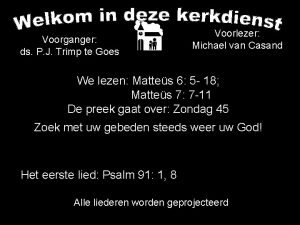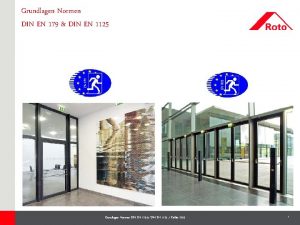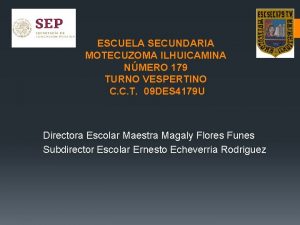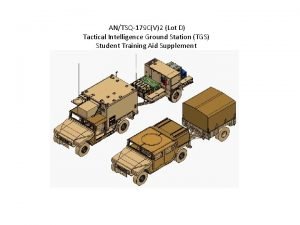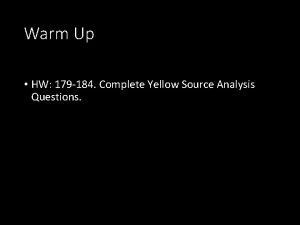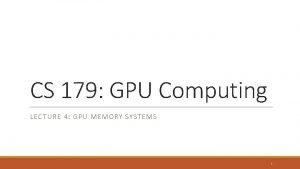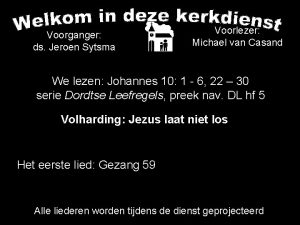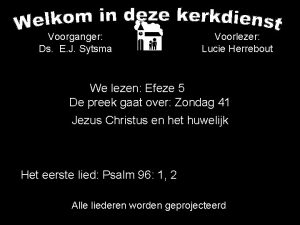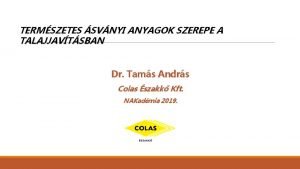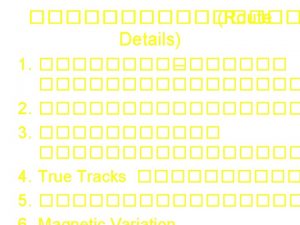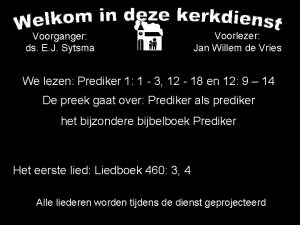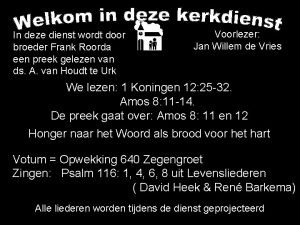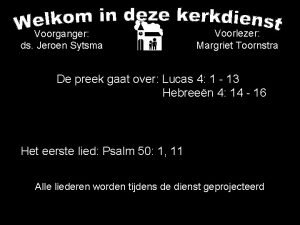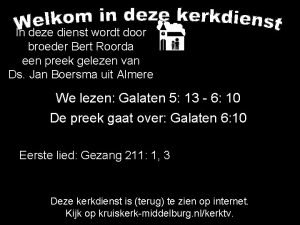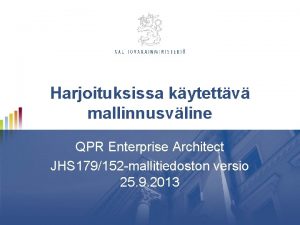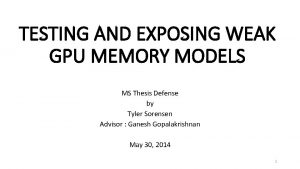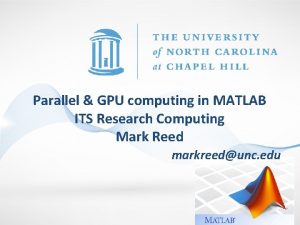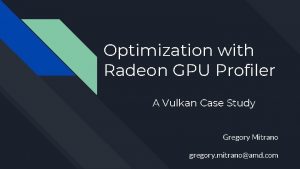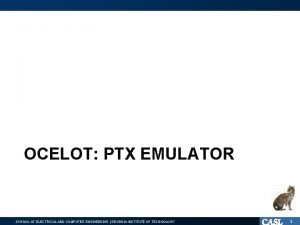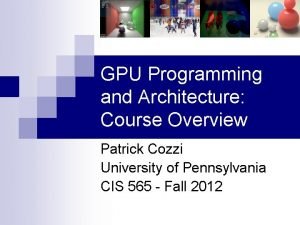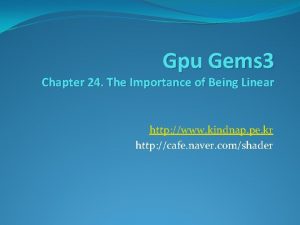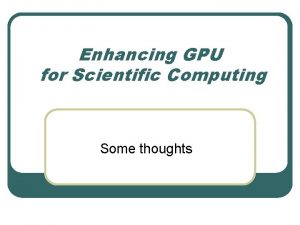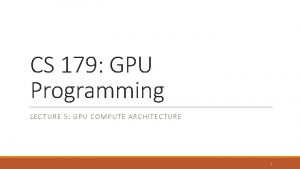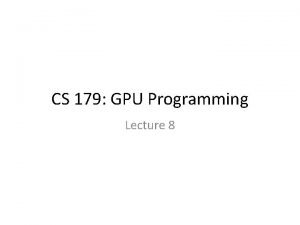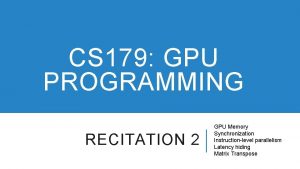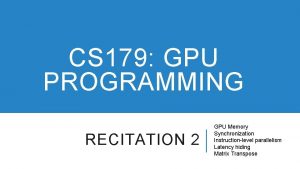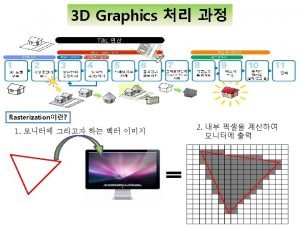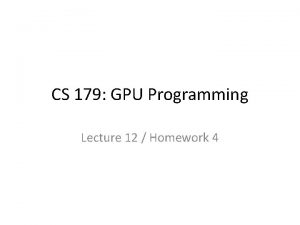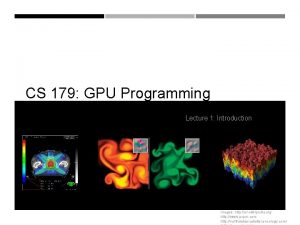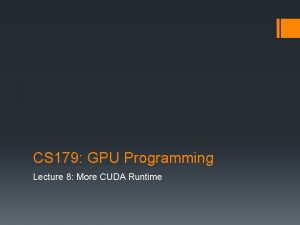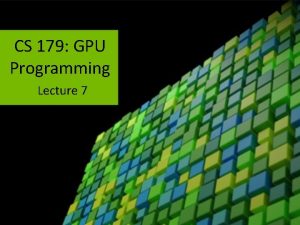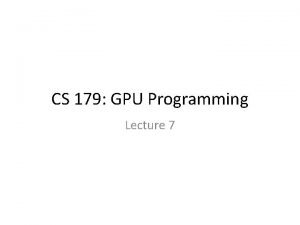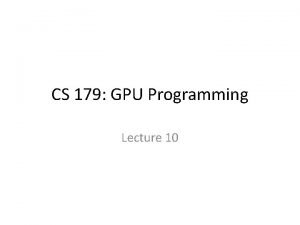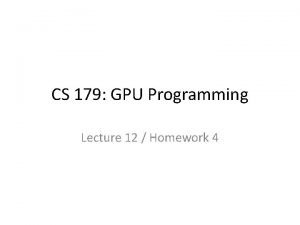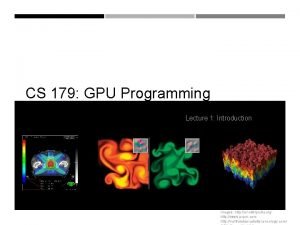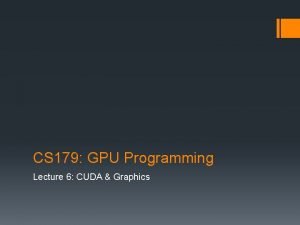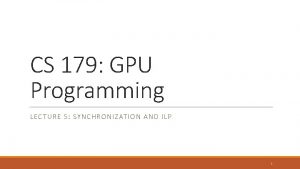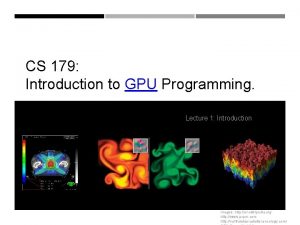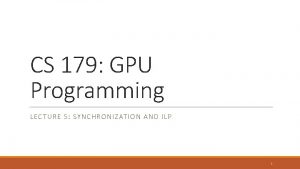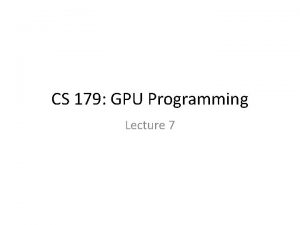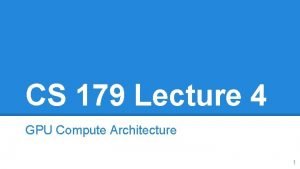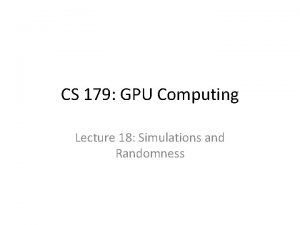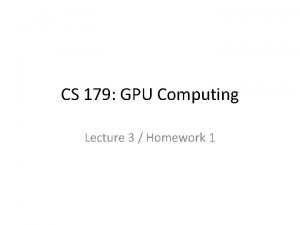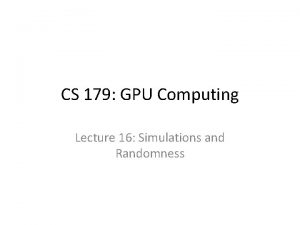CS 179 GPU Programming Lecture 8 Last time









































- Slides: 41

CS 179: GPU Programming Lecture 8

Last time • GPU-accelerated: – – Reduction Prefix sum Stream compaction Sorting (quicksort)

Today • GPU-accelerated Fast Fourier Transform • cu. FFT (FFT library) • This lecture – details behind FFT algorithm. Shows why you shouldn’t re-invent the wheel! – Don’t implement what a library already does for you, if you don’t have to! • It’s not TOO critical for the HW for many of the details about this math – mostly background. • We will use this FFT in the final weeks of lecture before projects, for implementing CONVOLUTIONAL NETWORKS on GPUs.

Signals (again)

“Frequency content” • FT answers question: “What frequencies are present in our signals? ” • Key to field of Digital Signal Processing -- see https: //en. wikipedia. org/wiki/Digital_signal_processing • Time domain – higher frequencies are higher pitch • Spatial domain – works similarly, but with “x” instead of “t”

Eqns for Continuous Fourier Transform • Fourier Transform (one of several formulations) – See https: //en. wikipedia. org/wiki/Fourier_transform • • Starts with input continuous function f(x) where x is in the spatial domain or f(t) for time domain, – to output continuous function in frequency domain, w for time frequency, or x for spatial frequency • Integral is “similar” to a matrix multiply, where integrand has two variables like 2 D matrix, and x is like row in matrix, and column in f(x), and the integral is like the sum.

Discrete Fourier Transform (DFT) • Main DFT Formulation: – Converts Time Domain input, (little) xn to – Frequency domain Output, (big) Xk • Similar to continuous defn, where we can see the 2 D matrix in the exponential, times the column vector (little) xn. where k is wave number.

Discrete Fourier Transform (DFT) •

Converting (little) xn to (big) Xk Solid line = real part Dashed line = imaginary part

Discrete Fourier Transform (DFT) •

Discrete Fourier Transform (DFT) •

Roots of Unity on Complex Plane Only N values of not N 2 for all integers k and n!

Discrete Fourier Transform (DFT) • Number of distinct values: N, not N 2!

Re-expressing DFT, for Proof where

(Proof -- -- breaks DFT into two DFTs, even/odd) • kk kkkk

(Proof of Recursion) •

(Proof of Recursion) •

(Proof of Recursion) •

(Proof of Recursion) • DFT of xn, even n! DFT of xn, odd n!

(Divide-and-conquer algorithm) Recursive-FFT(Vector x): if x is length 1: return x x_even <- (x 0, x 2, . . . , x_(n-2) ) x_odd <- (x 1, x 3, . . . , x_(n-1) ) y_even <- Recursive-FFT(x_even) y_odd <- Recursive-FFT(x_odd) for k = 0, …, (n/2)-1: y[k] <- y_even[k] + wk * y_odd[k] y[k + n/2] <- y_even[k] - wk * y_odd[k] return y

(Divide-and-conquer algorithm) Recursive-FFT(Vector x): if x is length 1: return x x_even <- (x 0, x 2, . . . , x_(n-2) ) x_odd <- (x 1, x 3, . . . , x_(n-1) ) y_even <- Recursive-FFT(x_even) y_odd <- Recursive-FFT(x_odd) for k = 0, …, (n/2)-1: y[k] <- y_even[k] + wk * y_odd[k] y[k + n/2] <- y_even[k] - wk * y_odd[k] return y T(n/2) O(n)

Runtime • Recurrence relation: – T(n) = 2 T(n/2) + O(n) O(n log n) runtime! Much better than O(n 2) • (Minor caveat: N must be power of 2) – Usually resolvable

Parallelizable? • O(n 2) algorithm certainly is! for k = 0, …, N-1: for n = 0, …, N-1: . . . • Sometimes parallelization of “bad” algorithm can outweigh runtime for “better” algorithm! – (N-body problem, …)

Culey Tukey Recursive Algorithm for FFT • See https: //en. wikipedia. org/wiki/Cooley%E 2%80%93 Tukey_FFT_algorithm • Recursively re-expresses discrete Fourier transform (DFT) of an arb composite size N = N 1 N 2 in terms of N 1 smaller DFTs of sizes N 2, recursively Reduces computation time to O(N log N) for highly composite N (smooth numbers). Specific variants and implementation styles have become known by their own names

Recursive index tree x 0, x 1, x 2, x 3, x 4, x 5, x 6, x 7 x 0, x 2, x 4, x 6 x 0, x 4 x 0 x 1, x 3, x 5, x 7 x 2, x 6 x 4 x 2 x 1, x 5 x 6 x 1 x 3, x 7 x 5 x 3 x 7

Recursive index tree x 0, x 1, x 2, x 3, x 4, x 5, x 6, x 7 x 0, x 2, x 4, x 6 x 0, x 4 x 0 x 1, x 3, x 5, x 7 x 2, x 6 x 4 x 2 x 1, x 5 x 6 x 1 x 3, x 7 x 5 x 3 Order? x 7

Bit-reversal order 0 4 2 6 1 5 3 7 000 100 010 110 001 101 011 111

Bit-reversal order 0 4 2 6 1 5 3 7 000 100 010 110 001 101 011 111 reverse of… 000 001 010 011 100 101 110 111 0 1 2 3 4 5 6 7

(Divide-and-conquer algorithm review) Recursive-FFT(Vector x): if x is length 1: return x x_even <- (x 0, x 2, . . . , x_(n-2) ) x_odd <- (x 1, x 3, . . . , x_(n-1) ) y_even <- Recursive-FFT(x_even) y_odd <- Recursive-FFT(x_odd) for k = 0, …, (n/2)-1: y[k] <- y_even[k] + wk * y_odd[k] y[k + n/2] <- y_even[k] - wk * y_odd[k] return y T(n/2) O(n)

Iterative approach x 0, x 1, x 2, x 3, x 4, x 5, x 6, x 7 Stage 3 x 0, x 2, x 4, x 6 x 1, x 3, x 5, x 7 Stage 2 x 0, x 4 x 2, x 6 x 1, x 5 x 3, x 7 Stage 1 x 0 x 4 x 2 x 6 x 1 x 5 x 3 Bit-reversed accesses (a la sum reduction) x 7

Iterative approach Bit-reversed access Stage 1 Stage 2 Stage 3 http: //staff. ustc. edu. cn/~csli/graduate/algorithms/book 6/chap 32. htm

Iterative approach Bit-reversed access Stage 1 Stage 2 Stage 3 Iterative-FFT(Vector x): y <- (bit-reversed order x) N <- y. length for s = 1, 2, …, lg(N): m <- 2 s wn <- e 2πj/m for k: 0 ≤ k ≤ N-1, stride m: for j = 0, …, (m/2)-1: u <- y[k + j] t <- (w n)j * y[k + j + m/2] y[k + j] <- u + t y[k + j + m/2] <- u - t return y http: //staff. ustc. edu. cn/~csli/graduate/algo rithms/book 6/chap 32. htm

CUDA approach Bit-reversed access Stage 1 Stage 2 Stage 3 http: //staff. ustc. edu. cn/~csli/graduate/algorithms/book 6/chap 32. htm

CUDA approach __syncthreads() barriers! Bit-reversed access Stage 1 Stage 2 Stage 3 http: //staff. ustc. edu. cn/~csli/graduate/algorithms/book 6/chap 32. htm

CUDA approach Non-coalesced memory access!! Bit-reversed access __syncthreads() barriers! Stage 1 Stage 2 Stage 3 http: //staff. ustc. edu. cn/~csli/graduate/algorithms/book 6/chap 32. htm

CUDA approach Non-coalesced memory access!! Bit-reversed access Bank conflicts!! Stage 1 Stage 2 __syncthreads() barriers! Stage 3 http: //staff. ustc. edu. cn/~csli/graduate/algorithms/book 6/chap 32. htm

CUDA approach Non-coalesced memory access!! Bit-reversed access Bank conflicts!! Stage 1 Stage 2 __syncthreads() barriers! Stage 3 THIS IS WHY WE HAVE LIBRARIES http: //staff. ustc. edu. cn/~csli/graduate/algorithms/book 6/chap 32. htm

cu. FFT • FFT library included with CUDA – Approximately implements previous algorithms • (Cooley-Tukey/Bluestein) • Also handles higher dimensions – Handles nasty hardware constraints that you don’t want to think about • Also handles inverse FFT/DFT similarly – Just a sign change in complex terms

cu. FFT 1 D example Correction: Remember to use cufft. Destroy(plan) when finished with transforms

cu. FFT 3 D example Correction: Remember to use cufft. Destroy(plan) when finished with transforms

Remarks • As before, some parallelizable algorithms don’t easily “fit the mold” – Hardware matters more! • Some resources: – Introduction to Algorithms (Cormen, et al), aka “CLRS”, esp. Sec 30. 5 – “An Efficient Implementation of Double Precision 1 -D FFT for GPUs Using CUDA” (Liu, et al. )
 01:640:244 lecture notes - lecture 15: plat, idah, farad
01:640:244 lecture notes - lecture 15: plat, idah, farad C programming lecture
C programming lecture Randy pausch the last lecture summary
Randy pausch the last lecture summary Perbedaan linear programming dan integer programming
Perbedaan linear programming dan integer programming Greedy programming vs dynamic programming
Greedy programming vs dynamic programming What is system programing
What is system programing Integer programming vs linear programming
Integer programming vs linear programming Definisi integer
Definisi integer Start time, end time and elapsed time
Start time, end time and elapsed time Gezang 179
Gezang 179 Pancaindera anugerah allah
Pancaindera anugerah allah Gezang 179
Gezang 179 Jhs 179
Jhs 179 Himno 179
Himno 179 En 179 und en 1125
En 179 und en 1125 Secundaria motecuzoma
Secundaria motecuzoma Mdas antenna
Mdas antenna Hw-179
Hw-179 Gezang 179
Gezang 179 Cs 179
Cs 179 Ds jeroen sytsma
Ds jeroen sytsma Gezang 179
Gezang 179 Asl 184
Asl 184 Bodrogkeresztúri riolittufa
Bodrogkeresztúri riolittufa 0-179 altitude
0-179 altitude Liedboek 460
Liedboek 460 Prosessikaavio pohja
Prosessikaavio pohja Frank roorda
Frank roorda Dot
Dot Gezang 179
Gezang 179 Gezang 179
Gezang 179 Prosessikartta malli
Prosessikartta malli Gpu memory test
Gpu memory test Gpgpu matlab
Gpgpu matlab Vulkan optimization
Vulkan optimization Gpu ocelot
Gpu ocelot Grafikkarte funktion
Grafikkarte funktion Gpu architecture course
Gpu architecture course Gpu gems 3
Gpu gems 3 Gpu acceleration matlab
Gpu acceleration matlab Best gpu for scientific computing
Best gpu for scientific computing Cache coherence for gpu architectures
Cache coherence for gpu architectures









